Overview
Database connectors are indispensable software components that enable seamless communication between applications and data storage systems. This functionality is vital for efficient data retrieval and integration, which are crucial for data-driven operations. How do these connectors enhance organizational capabilities? By streamlining processes, supporting various data storage types, and empowering organizations to make informed decisions based on real-time data, they play a pivotal role in modern information integration strategies. As a result, investing in robust database connectors can significantly improve operational efficiency and decision-making capabilities.
Introduction
In the digital age, the ability to seamlessly connect applications with databases is more crucial than ever. Database connectors serve as the backbone of this integration, enabling organizations to harness data effectively for operational success. As businesses increasingly rely on diverse data sources, understanding the nuances of these connectors—from their types and technical requirements to their real-world applications—becomes essential.
Furthermore, with the rapid evolution of technology, organizations face both opportunities and challenges in implementing robust database solutions. This article delves into the significance of database connectors, exploring their functionalities, common use cases, and best practices for ensuring secure and efficient data integration.
As companies navigate the complexities of digital transformation, leveraging the right database connectors can provide a competitive edge in an ever-changing landscape. Are you ready to unlock the full potential of your data integration strategies?
Defining Database Connectors: An Overview
A database connector serves as a pivotal software component that facilitates communication between applications and data storage systems. Acting as a bridge, it empowers client applications to send queries and retrieve data from the database server, which is vital for the functionality of data-driven applications. This seamless flow of information is essential for operations, reporting, and analytics, enabling organizations to make informed decisions based on real-time data.
Avato’s dedicated hybrid platform maximizes and extends the value of legacy systems by simplifying complex connections and significantly reducing costs. This platform features real-time monitoring and alerts on system performance, ensuring that organizations can proactively manage their integrations. Data links support a range of data storage types, including relational systems like MySQL and PostgreSQL, as well as NoSQL systems.
Their versatility is particularly significant in today’s environment, where businesses increasingly rely on various information sources to drive their operations. Recent trends indicate that over 70% of organizations employ a database connector to enhance their information-driven applications, underscoring its importance in contemporary information integration strategies.
The importance of database links, as a type of database connector, transcends mere connectivity; they play a crucial role in ensuring that information flows seamlessly between different systems. For example, as the digital marketing sector expands, the proliferation of advertising platforms has created a demand for a diverse range of data interfaces. Organizations can now access a directory of over 500 links, enabling them to integrate with various platforms and enhance their analytical capabilities.
This integration not only streamlines processes but also empowers businesses to make data-driven marketing decisions more effectively. Moreover, a recent survey revealed that 10% of companies face delays in onboarding new supply chain partners due to inadequate application integration, primarily resulting from legacy systems and a lack of effective integration tools. This statistic underscores the essential need for robust links that can connect outdated systems with contemporary applications—a challenge that Avato addresses through its innovative solutions.
In summary, understanding the function of these links is crucial for organizations striving to successfully integrate their information systems. As companies continue to navigate the complexities of digital transformation, the ability to leverage reliable and effective data links will be paramount for maintaining a competitive edge and adapting to evolving requirements. Avato’s commitment to providing a dependable, future-proof technology stack further supports businesses in this endeavor, ensuring they can meet changing demands without compromising performance.
As Kenza Sallier noted, fostering consistency and comparability within information amalgamation is vital for achieving successful outcomes.
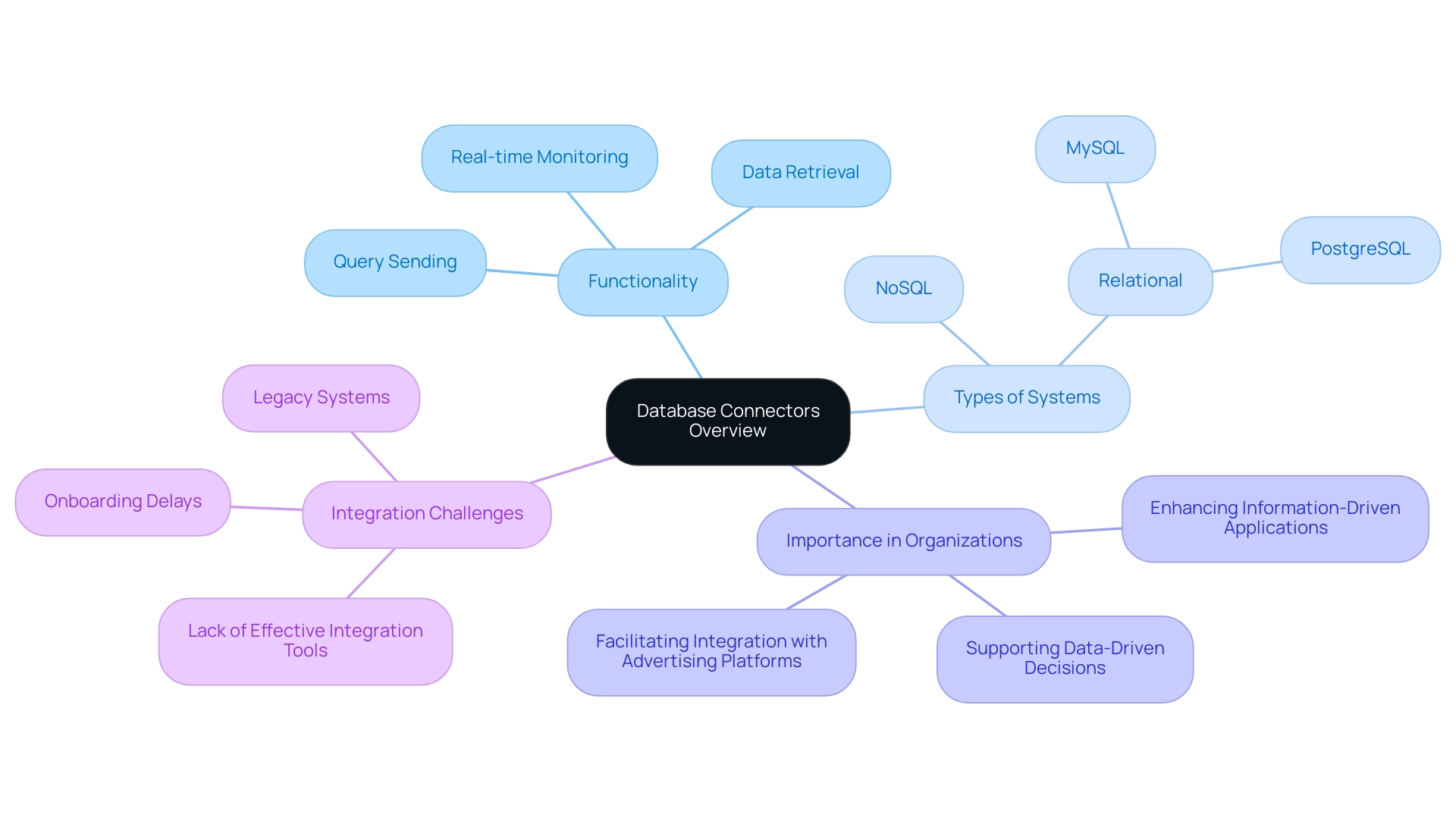
Types of Database Connectors: A Comprehensive Guide
Data links are pivotal in facilitating seamless information integration across various systems, and they can be categorized based on their functionality and the data systems they support. The primary types include:
- JDBC Interfaces: Designed for Java applications, JDBC interfaces utilize Java Database Connectivity (JDBC) standards to forge connections with relational data stores. Their robustness and compatibility with diverse data management systems make them a staple in enterprise applications. As of 2025, JDBC interfaces command a significant market share, especially in Java-centric environments.
- ODBC Interfaces: Open Database Connectivity (ODBC) interfaces provide a universal method for applications to connect with multiple data sources, regardless of the underlying data management system. This flexibility renders ODBC a preferred choice for organizations aiming to integrate varied information sources, particularly in scenarios that require extensive compatibility among different information management systems.
- REST API Interfaces: These interfaces empower applications to interact with databases through RESTful APIs, facilitating efficient data exchange over HTTP. REST API integrations are increasingly favored for their capacity to support modern web applications and microservices architectures. Recent statistics reveal a growing adoption of REST API links among enterprises, reflecting a shift towards more agile and scalable integration solutions.
- Custom Links: Tailored solutions that cater to specific connection requirements, custom links are often crafted to fulfill unique business needs. They provide organizations with the flexibility to connect disparate systems that may not be compatible with standard interfaces.
Each type of link serves distinct use cases, making it crucial for organizations to select the appropriate one based on their technology stack and connection objectives. Avato’s hybrid integration platform enhances the capabilities of these links, enabling companies to future-proof their operations through seamless information and system integration. Expert insights indicate that choosing the right link to the data storage system is vital for optimizing performance and ensuring smooth data transfer.
For instance, technology specialists emphasize the importance of evaluating the specific characteristics of each type to align with organizational goals and existing infrastructure.
A practical example of a data link in action is Microsoft SQL Server Integration Services (SSIS), which automates workflows and integrates effortlessly with SQL Server, providing robust error-handling and logging features, albeit accommodating a limited variety of systems. Additionally, Apache Nifi serves as a real-time information ingestion platform that supports diverse formats and offers provenance tracking, further enriching the discussion on the types of links and their functionalities.
Moreover, the current landscape of database connection solutions encompasses the top 10 database connectors, including JDBC, ODBC, ADO.NET, among others, which illustrate their functionalities and use cases. This broader perspective is essential for organizations striving to enhance their information unification strategies and achieve operational efficiency. By leveraging Avato’s specialized hybrid connection platform, enterprises can streamline their integration processes and unlock the full potential of their information resources.
In summary, understanding the various types of data links and their functionalities is critical for organizations seeking to refine their data integration strategies and attain operational efficiency. As Tony Leblanc from the Provincial Health Services Authority aptly states, “Good team. Good people to work with. Extremely professional. Extremely knowledgeable.” This testimonial highlights the necessity of effectively conveying the value of these technologies in driving business success.
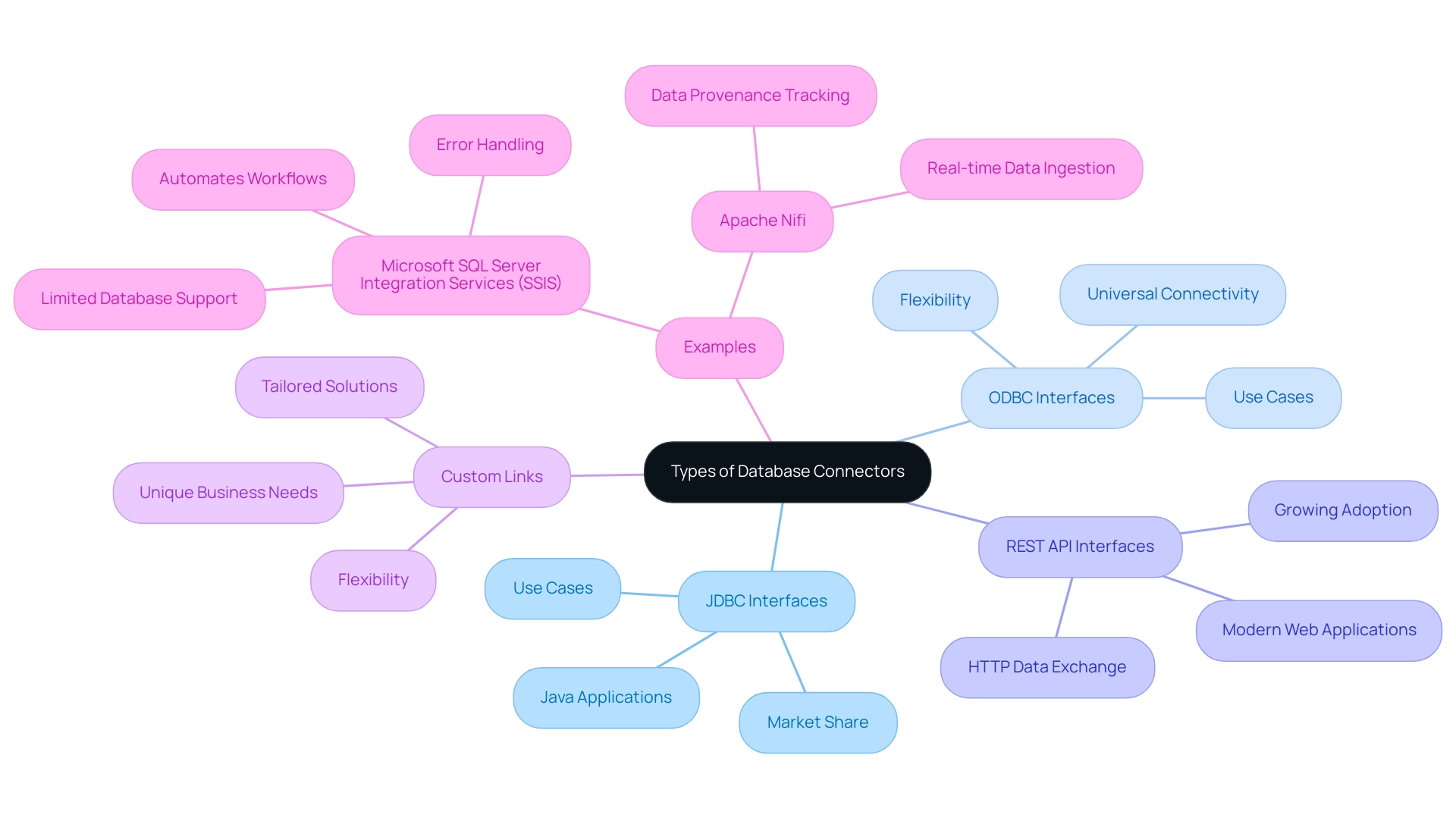
Technical Requirements for Database Connectors: What You Need to Know
To successfully establish a data link, organizations must navigate several critical technical requirements.
- Database Compatibility: Verifying that the link is compatible with the specific data management system in use is essential. Many organizations face compatibility issues during implementation, leading to significant delays and increased costs. Avato addresses this challenge by ensuring 24/7 uptime for critical integrations, allowing businesses to maintain operational continuity.
- Driver Installation: The installation of specific drivers, such as JDBC or ODBC, is often required for effective communication between the application and the database. Ensuring the correct drivers are installed is vital for seamless integration.
- Network Configuration: Proper network settings, including configuring firewall rules and IP whitelisting, are crucial for facilitating secure connections. A well-organized network setup can prevent unauthorized access and ensure information integrity.
- Authentication Protocols: Implementing robust authentication methods, such as OAuth or SSL, is critical for safeguarding information during transmission. Security breaches can occur if authentication protocols are not adequately addressed, making this a top priority for organizations.
- Performance Considerations: Organizations must assess the database connector’s capacity to manage expected data loads and query performance. Failure to evaluate these factors can result in bottlenecks that hinder operational efficiency. Avato’s hybrid unification platform has been praised for simplifying complex projects, enabling organizations to achieve results within desired time frames and budget constraints, as noted by customer Gustavo Estrada. Furthermore, the platform’s robust analytics capabilities allow for continuous monitoring of performance, providing insights that help optimize operations and enhance customer experiences. This aligns with the user manual’s directive to ensure that connection solutions offer robust analytics capabilities.
By meticulously addressing these technical aspects and engaging stakeholders throughout the process, organizations can facilitate a smooth connection and future-proof their systems. Incorporating data links streamlines information flow from various sources, enhancing analytics efficiency and operational effectiveness. Avato differentiates itself from competitors by providing speed, security, and simplicity in integration while ensuring compliance with regulatory standards and conducting thorough security audits. These technical requirements are crucial for organizations in the banking sector.
Common Use Cases for Database Connectors in Business
Database interfaces play a pivotal role in various business scenarios, addressing critical needs such as information transfer, real-time processing, and application development.
Information Transfer: Organizations frequently utilize system links to facilitate the seamless movement of information from legacy systems to modern storage solutions. This process not only ensures continuity but also upholds integrity, essential for businesses navigating digital transformation. Avato exemplifies the reliability of database connectors in maintaining operational continuity, particularly in sectors like banking and healthcare, with its commitment to 24/7 uptime for crucial connections. Business Intelligence (BI) tools rely on database connectors, which are vital for integrating information from diverse sources. This integration fosters comprehensive analytics and reporting, empowering organizations to extract actionable insights from their data. Companies employing Avato’s integration tools can enhance their decision-making processes by accessing real-time analytics. As noted by Gustavo Estrada, a client, Avato streamlines complex projects and delivers results within preferred timelines and budget constraints, showcasing the efficiency of integration tools in facilitating information transfer and business insights.
Real-Time Information Processing: In industries such as finance and healthcare, the capacity for real-time updates is indispensable. Avato’s integration tools empower organizations to swiftly respond to evolving conditions, thereby enhancing operational efficiency and supporting critical decision-making processes.
Application Development: Developers depend on information links to create applications that require flexible data access. This capability not only enhances user experiences but also broadens application functionality, making them more responsive to user needs.
These varied use cases underscore the adaptability and significance of integration tools in driving business success and fostering innovation. For instance, the OAS Recipe product illustrates how interface links can enhance two-way feedback between PLCs and information systems, ensuring precise information handling and error management. Such capabilities are vital across numerous industrial applications, demonstrating the transformative impact of Avato’s integration tools on business intelligence analytics and information migration strategies.
Additionally, it is crucial to distinguish between ETL (Extract, Transform, Load) and ELT (Extract, Load, Transform). ETL modifies information prior to loading, whereas ELT loads information before modification. This distinction is pertinent to the discussion of system links and their role in information unification solutions.
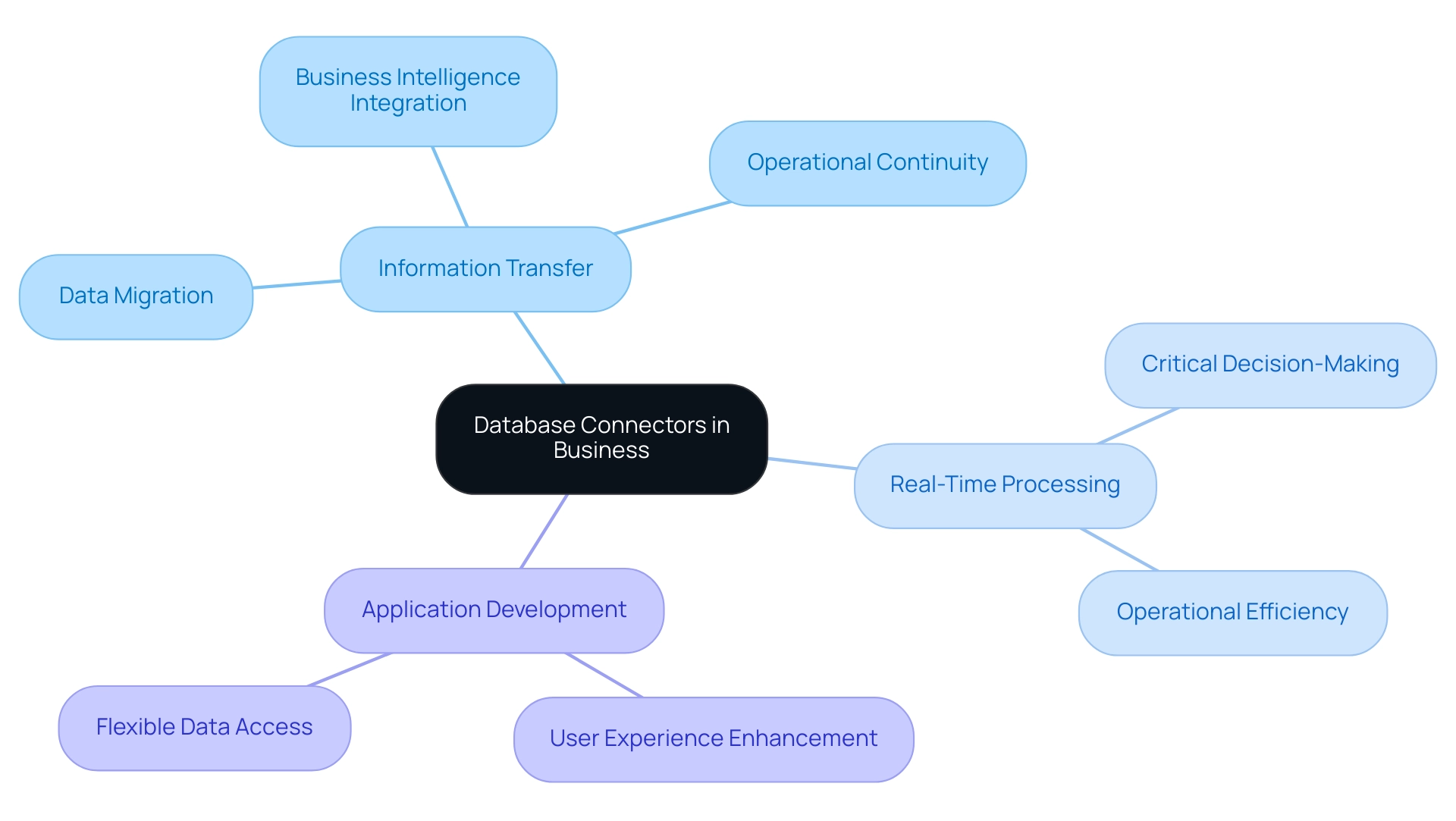
Setting Up a Database Connector: Step-by-Step Configuration
Establishing a data link is an essential procedure that can significantly enhance information unification within a company. Here’s a detailed guide to ensure a successful implementation:
-
Choose the Right Database Connector: Begin by selecting a database connector that aligns with your specific data system type and connection needs. This choice is crucial, as it directly impacts the overall performance and compatibility of your integration efforts.
-
Install Required Drivers: Download and install the necessary drivers, such as JDBC or ODBC, which facilitate communication between your application and the data store. Ensuring that the correct drivers are in place is vital for seamless connectivity.
-
Configure Connection Settings: Input the database URL, user credentials, and any additional parameters required for the connection. Key configuration settings may include timeout values, connection pooling options, and security protocols—essential for maintaining a secure and efficient connection.
-
Test the Connection: Before deployment, rigorously test the connection to confirm that it functions correctly and can handle the expected query load. This step is critical for identifying potential issues early in the process, thereby minimizing disruptions later on.
-
Monitor Performance: After establishing the link, continuously observe its performance using robust analytics capabilities. Regular performance assessments can help identify bottlenecks or failures, allowing for prompt resolution and ensuring that the system remains efficient. This continuous monitoring is essential for optimizing operations and enhancing customer experiences, enabling organizations to adapt swiftly to changing demands.
By following these steps, organizations can achieve successful execution of database connectors, which is vital for effective data unification. In fact, firms that adhere to best practices in setting up connections often report higher success rates in their unification projects. For instance, organizations utilizing Avato’s hybrid connection platform have experienced significant improvements in performance metrics, demonstrating the value of a reliable technology stack in adapting to changing demands.
Notably, Avato’s platform can accommodate data repositories of all sizes, from small to over 10 TB, ensuring scalability for various integration needs.
Additionally, successful case studies emphasize that the typical time needed to establish a link can be minimized to just weeks, rather than months, when following a systematic approach. This efficiency not only accelerates digital transformation initiatives but also enhances operational capabilities, allowing businesses to maintain a competitive edge in their respective industries. As Gustavo Estrada, a customer, noted, “Avato simplifies complex projects and delivers results within desired time frames and budget constraints,” further underscoring the effectiveness of a structured approach in setting up a database connector.
Call to Action: To learn more about how Avato can enhance your merging efforts, download our comprehensive guide now or contact us for a demo. Discover how our solutions can transform your data integration processes and propel your business forward.
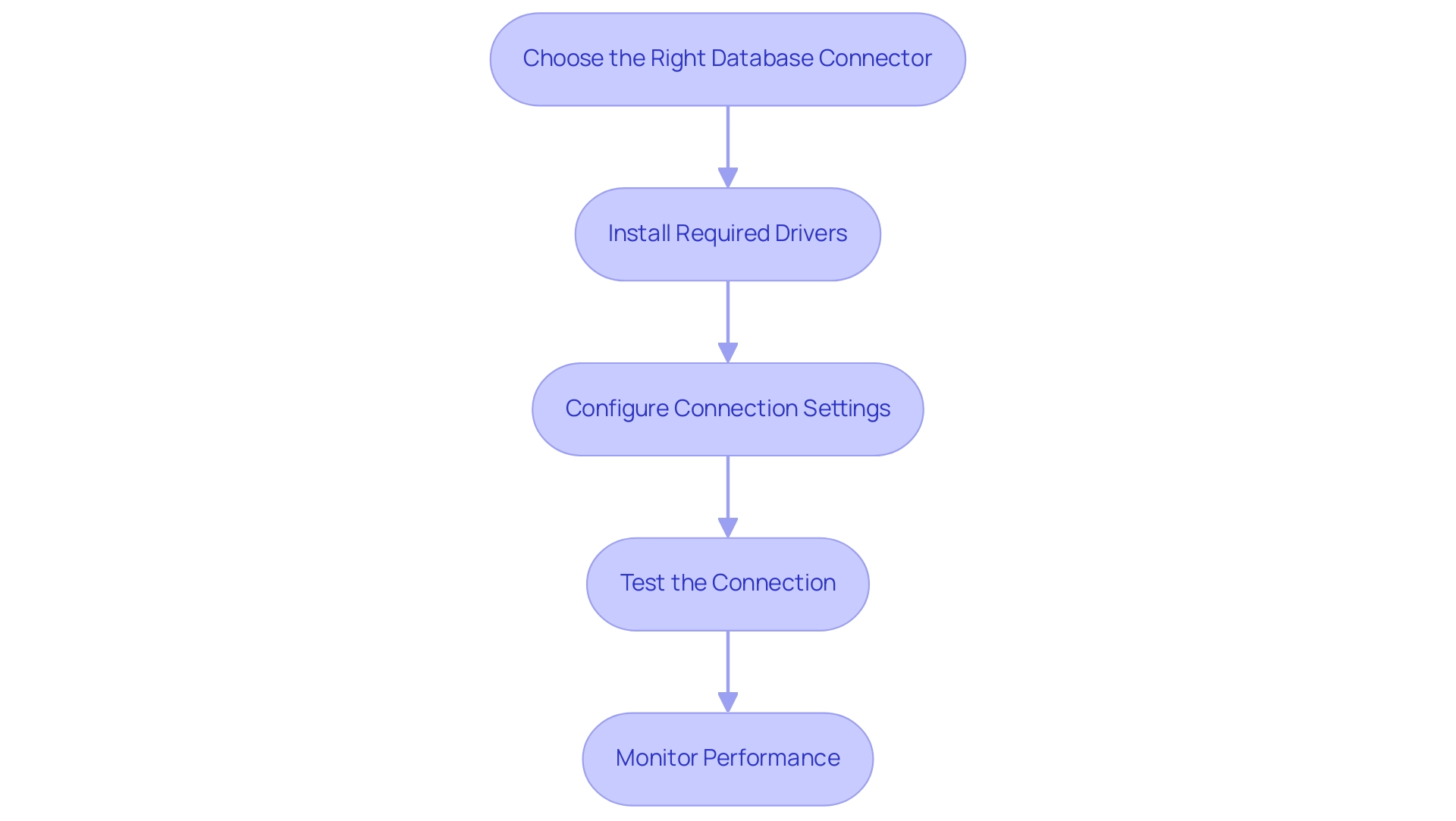
Challenges and Considerations in Database Connector Implementation
Implementing database connectors presents significant challenges that organizations must navigate to ensure successful integration.
Compatibility Issues: Ensuring that the connector is compatible with both the application and the database can be particularly complex, especially when dealing with legacy systems. A staggering percentage of organizations—over 60%—report encountering compatibility issues during implementation, obstructing unification efforts and delaying project timelines. Avato’s hybrid integration platform simplifies these complexities, ensuring seamless connectivity across disparate systems and enabling organizations to unlock isolated assets.
Performance Bottlenecks: Inadequately set up links frequently result in performance bottlenecks, causing sluggish information retrieval and processing durations. Recent studies indicate that nearly 40% of organizations experience performance degradation due to inefficient database connectors, severely impacting overall application performance and user experience. Avato addresses these issues by providing robust performance monitoring tools that help organizations detect and resolve bottlenecks promptly, ensuring efficient operations.
Security Risks: Database connections can be vulnerable to various security threats, including SQL injection and unauthorized access. Implementing robust security measures is essential to protect sensitive information and maintain compliance with industry regulations. Organizations must prioritize security protocols to mitigate these risks effectively. Avato’s commitment to security ensures that its solutions incorporate stringent measures, including encryption and access controls, safeguarding against potential threats.
Quality Concerns: Inconsistent formats and definitions can lead to significant quality issues, complicating integration efforts. Organizations must establish clear information governance practices to ensure integrity and consistency across systems. Avato supports businesses in developing comprehensive data governance frameworks, enhancing overall data quality and reliability, which is crucial for future-proofing operations.
Legal and Ethical Challenges: Organizations must navigate legal and ethical issues, such as privacy protection and informed consent, complicating the implementation of data links. Avato’s solutions are designed with compliance in mind, helping organizations adhere to necessary regulations while integrating their systems.
To overcome these challenges, organizations can adopt several strategies:
- Thorough Testing: Conducting extensive testing of database connectors in a controlled environment can help identify compatibility issues before full-scale implementation.
- Performance Monitoring: Implementing real-time monitoring tools can help organizations detect and address performance bottlenecks promptly.
- Security Protocols: Establishing stringent security measures, including encryption and access controls, can protect connections against potential threats.
- Information Governance: Creating a comprehensive information governance framework can ensure consistent formats and definitions, enhancing overall quality.
By proactively tackling these challenges, organizations can significantly enhance their implementation processes for the database connector, leading to more efficient and secure data connection solutions. As Gustavo Estrada pointed out, ‘Avato has the capacity to simplify complex projects and deliver results within desired time frames and budget constraints,’ demonstrating how Avato’s emphasis on speed, security, and simplicity effectively addresses these challenges. Additionally, a systematic approach, akin to the article selection process for systematic reviews, can help organizations refine their strategies for overcoming integration hurdles.
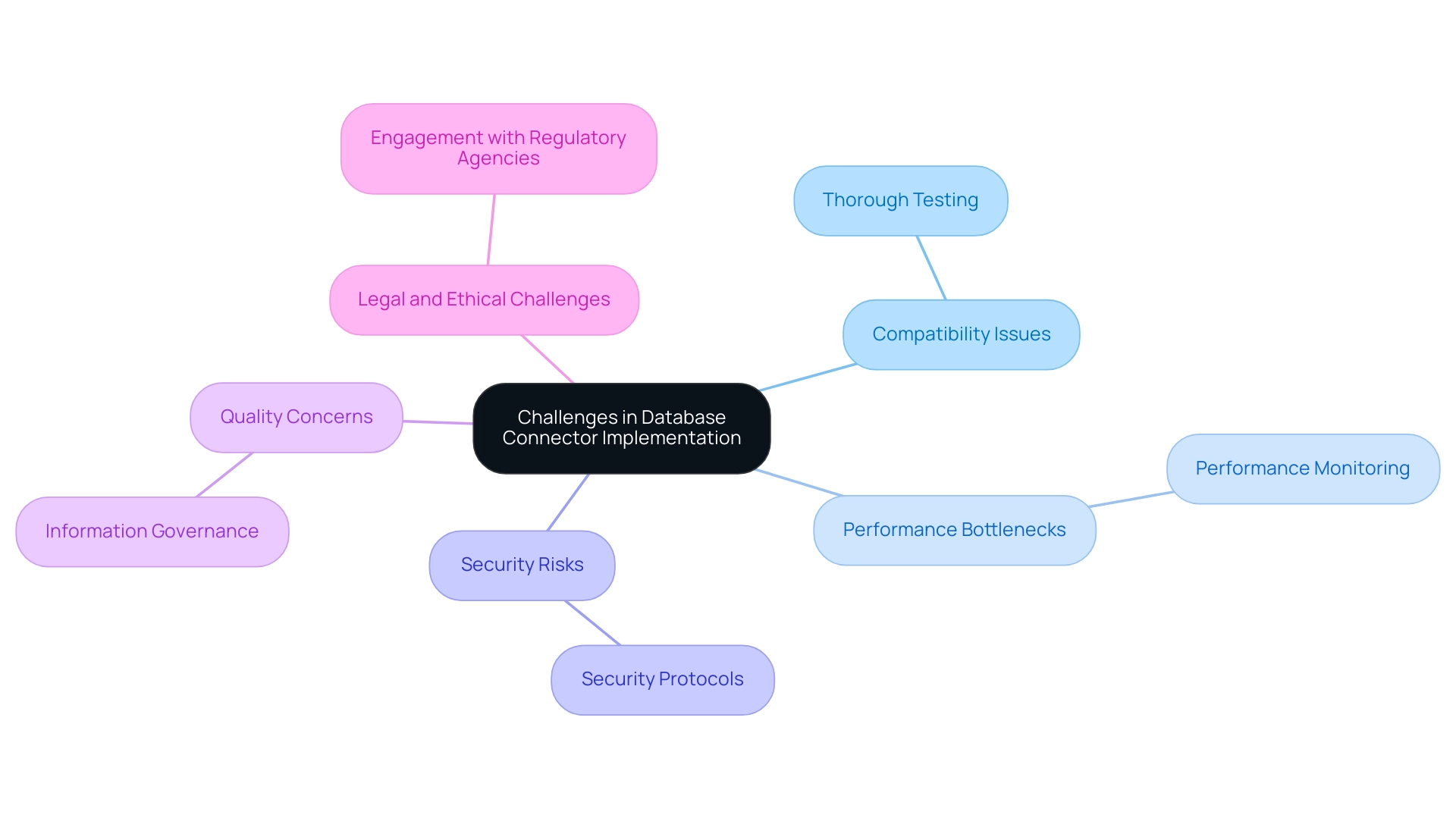
Ensuring Security in Database Connections: Best Practices
To ensure robust security in database connector connections, organizations must adopt best practices that not only protect sensitive information but also enhance operational integrity.
- Use Encrypted Connections: Implement SSL/TLS protocols to encrypt data in transit. This safeguards it from interception and unauthorized access. Avato guarantees 24/7 uptime for critical integrations, underscoring the importance of maintaining secure connections reliably.
- Implement Strong Authentication: Employ multi-factor authentication (MFA) and enforce strong password policies to restrict access to connection points. This approach enhances security and aligns with best practices recommended by cybersecurity experts, emphasizing the necessity of robust authentication methods in protecting sensitive data.
- Regularly Update Software: Keeping the database connector and drivers up to date is essential to mitigate risks associated with known vulnerabilities. Regular updates, including applying security patches, are fundamental to maintaining a secure environment.
- Limit Access: Adhere to the principle of least privilege by granting users only the access necessary for their roles. This minimizes potential exposure and reduces the risk of unauthorized access to critical systems.
- Monitor and Audit Connections: Conduct regular reviews of connection logs and monitor for unusual activity to detect potential security breaches. Establishing a proactive monitoring approach significantly enhances an organization’s capacity to react to threats in real-time.
By adhering to these best practices, organizations can considerably lower the risk of breaches and ensure the integrity of their connection systems. For instance, case studies on SQL Server security best practices illustrate that organizations implementing regular updates, firewalls, and anti-virus measures have seen marked improvements in their information governance and security posture. As Gustavo Estrada noted, Avato simplifies complex projects and delivers results within desired time frames and budget constraints, demonstrating how its platform effectively supports these security measures.
As the landscape of cybersecurity evolves, prioritizing encrypted connections and strong authentication methods remains paramount for safeguarding sensitive information.
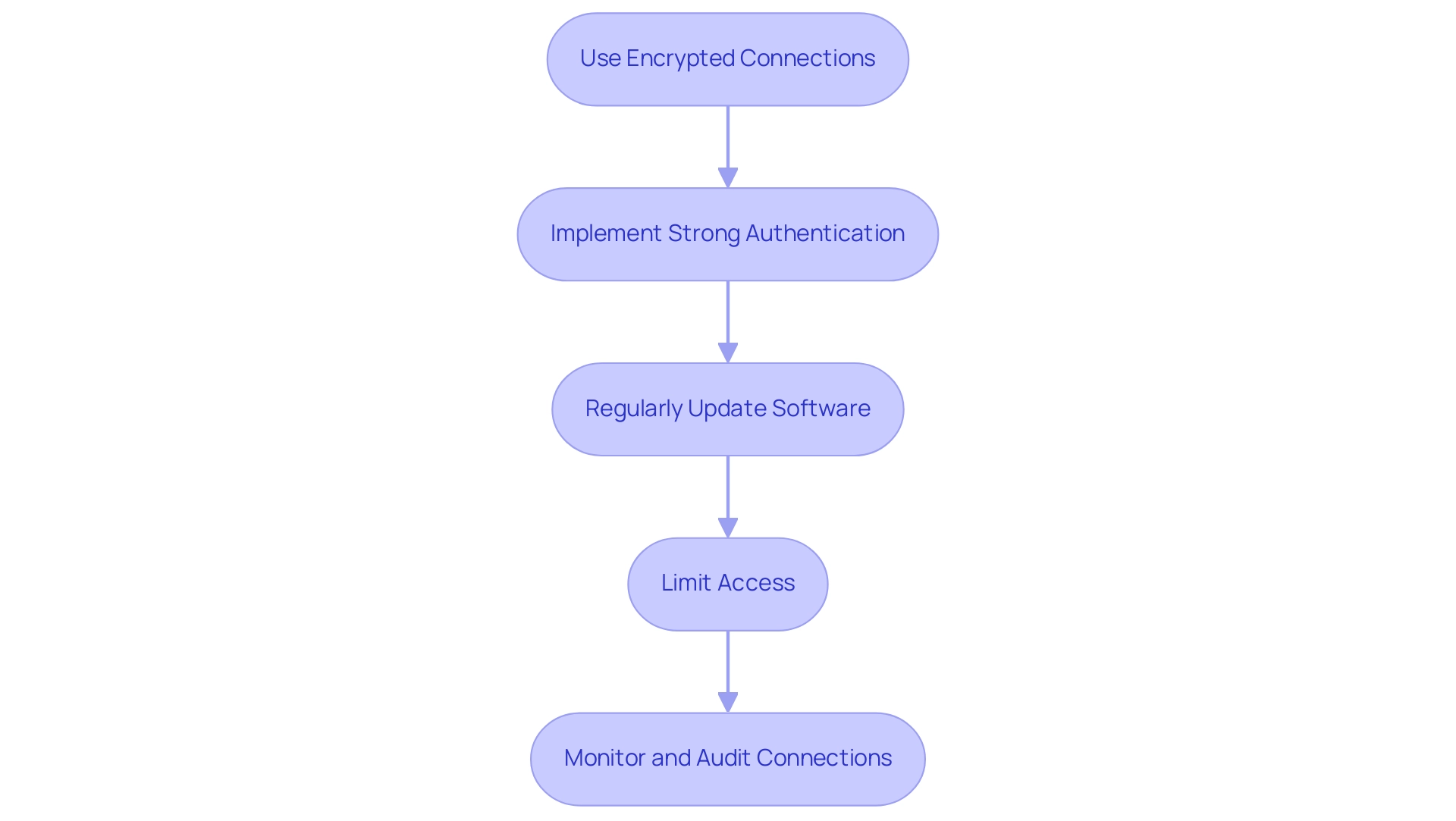
Future Trends in Database Connectors and Data Integration
The future of data links and information unification is poised for significant change, driven by various crucial trends, particularly as companies strive to modernize outdated systems and enhance their operational capabilities.
- Increased Automation: Automation is becoming essential for simplifying the setup and management of database connectors, which significantly reduces the need for manual intervention. This shift not only streamlines processes but also enhances operational efficiency, a core principle of Avato’s hybrid unification platform.
- AI and Machine Learning Unification: The integration of AI and machine learning technologies is revolutionizing information processing capabilities. These advancements enable smarter, more adaptive information amalgamation solutions that learn from patterns and optimize performance over time, empowering businesses to future-proof their operations.
- Cloud-Native Interfaces: As organizations increasingly transition to cloud environments, the demand for cloud-native database interfaces is surging. These links facilitate seamless unification across various cloud platforms, ensuring that companies can utilize their information efficiently in a hybrid environment. Notably, large companies accounted for over 69.70% of the revenue share in 2024, underscoring the significance of these trends in the context of market dynamics.
- Focus on Real-Time Information Processing: The rising demand for real-time access to information is propelling the development of links that facilitate streaming information integration. This capability enables organizations to make timely decisions based on the most current information available, enhancing responsiveness and agility. For instance, Rapidi’s solutions offer real-time information synchronization, allowing businesses to make informed decisions by integrating systems like Salesforce and Dynamics 365 Finance. With the increasing threat of breaches, future database connectors are expected to incorporate enhanced security features. These enhancements will be vital in safeguarding sensitive information and ensuring compliance with regulatory standards, particularly in regulated sectors where Avato excels.
As Gustavo Estrada pointed out, Avato simplifies complex projects and delivers results within desired time frames and budget limits, demonstrating the effectiveness of combined solutions in navigating these trends. By remaining attuned to these advancements, organizations can strategically position themselves to leverage emerging technologies, thereby sustaining a competitive advantage in the evolving landscape of information unification. Additionally, the convergence of ELT and ETL processes highlights the dynamic nature of data integration, with new processes like extract, transform, load, and transform (ETLT) emerging to continuously refine data quality for improved data mesh distribution.
To learn more about how Avato can assist in structuring your requirements management process and ensuring compliance in regulated industries, get your copy now.
Conclusion
The exploration of database connectors underscores their indispensable role in contemporary data integration strategies. These connectors facilitate seamless communication between applications and databases, enabling real-time data analytics—essential for organizations aiming for operational excellence. By understanding the various types of database connectors, such as JDBC, ODBC, REST API, and custom connectors, along with their specific functionalities, businesses can select the most suitable options tailored to their unique needs.
As organizations face the technical requirements and challenges of implementing database connectors, it becomes evident that meticulous planning and execution are crucial. Addressing compatibility issues, ensuring robust security measures, and maintaining data quality are critical steps for successful integration. The emphasis on best practices—like utilizing encrypted connections and conducting regular performance monitoring—cannot be overstated in safeguarding sensitive information and optimizing operational efficiency.
Looking ahead, the future of database connectors is poised for innovation, driven by trends such as increased automation, the integration of AI and machine learning, and the shift towards cloud-native solutions. These advancements promise to enhance data integration capabilities, empowering organizations to respond more effectively to the ever-evolving digital landscape.
Ultimately, leveraging the right database connectors not only streamlines operations but also provides businesses with a competitive edge in an increasingly data-driven world. By prioritizing strategic integration efforts, organizations can unlock the full potential of their data and drive meaningful insights, paving the way for sustained success in their respective industries.

